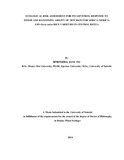| dc.description.abstract | Rice belongs to the family Poaceae and genus Oryza. Poaceae, on a world scale, is classified among the prominent families that are likely to produce invasive weed species hence a challenge on biosafety. Through modern biotechnology, new rice varieties referred to as the New Rice for Africa (NERICA) have been developed in West Africa. NERICA rice varieties are interspecific hybrids between the two cultivated Oryza species i.e. O. sativa L and O. glaberrima Steud. The varieties are at the verge of deployment in Kenya and other African countries. Being new varieties in the continent, there is limited information about their characteristics they have not been sufficiently investigated. Risk assessment is a requirement of the Cartagena Protocol and the Kenya Biosafety Act of 2009. There is therefore need for risk assessment, as a biosafety measure, particularly on invasiveness, before the NERICA varieties are widely deployed in Kenya. This study attempted to assess the potential ecological risk of selected upland NERICA and O. sativa rice varieties in central Kenya for invasiveness, response to weed interference and ratooning ability. Two kinds of study were carried out on; 1) the response to weed interference and the ratooning ability of four upland NERICA [NERICA-1 (WAB 450-1-B-P-38-HB), NERICA-4 (WAB 450-1-B-P-91-HB), NERICA-10 (WAB 450-11-1-1-P41-HB), NERICA-11 (WAB 450-16-2-BL2-DV1)] and one O. sativa [Dourado precoce, (WAB 56-104)] rice varieties and 2) the potential risk of invasiveness of the four NERICA rice varieties.
The study was carried out at Mwea Irrigation Agricultural Development (MIAD) Centre in Kirinyaga County, central Kenya. A two-factor split-plot randomized complete block design replicated three times was used. For both the main and the ratoon crop, data were collected on the growth and and yield parameters. The Australia Weed Risk Assessment Scheme was used to assess the potential risk of invasiveness of the rice varieties. Data were collected on traits potentially contributing to invasiveness which included the history, biogeography and biology of each rice variety. These were gathered from study one of the current study, literature and consultation with appropriate experts. Data on response to weed interference and ratooning ability was subjected to Analysis of Variance (ANOVA) at 5% significance level. The Least Significant Difference was used for mean separation at 5% significance level. The weed risk assessment scoring sheet was
used to score the data on invasiveness which were later analysed on Microsoft excel spreadsheet.
The occurrence and composition of weeds at the two study sites was similar and composed of broadleaves, grasses and sedges. The five most dominant weeds out of 44 species at study site one were Brachiara eruciformis, Sida ovata, Xanthium pungens, Portulaca oleracea and Euphorbia geniculata while site two had Brachiara eruciformis, Cyperus exaltatus, Dinebra retroflexa, Eclipta prostata and Hibiscus trionum as the five most common out of 48 species. Generally for the main and ratoon crop of NERICA and Duorado precoce, early weeding enhanced plant growth as well as yield and yield components. Leaf area index was however least affected by weeding treatments. From the main crop, the critical period of weed control for NERICA 1 and 4 was established as 3-6 weeks after planting while for NERICAs 10, 11 and Duorado precoce it is between 3-9 weeks after planting. On the ratoon crop, the critical period of weed control for the four NERICAs (NERICA 1, 4, 10 and 11) as well as the standard check Duorado precoce was similar and is between 3-6 weeks after cut back. Weed competition either before or after these critical periods had negligible effects on crop growth and yield.
Total grain yield differed significantly (p<0.05) among the rice varieties. NERICA rice varieties attained significantly (p<0.05) higher grain yield compared to the traditional upland Duorado precoce in both the main and the ratoon crop. NERICA 4 attained the highest total grain yield (6206 kg ha-1) followed by NERICA 1 (5781kg ha-1) while the Duorado precoce attained the lowest (3376kg ha-1). The yield increase of more than 1500 kg ha-1 (the average yield of upland rice in Sub-sahara Africa) recorded in NERICA 4 and NERICA 10 with no farm additional inputs was very encouraging. This will presumably increase with additional inputs during ratoon. Full season weed infestation resulted in 51 to 67% and 55 to 64% reduction in grain yield of the rice varieties for the main and ratoon crops respectively, confirming the vulnerability of the varieties to weed infestation. Ratooning ability varied significantly (p<0.05) among rice varieties with the NERICA varieties showing better ratooning ability than the standard check Duorado precoce. Among the NERICA varieties, NERICA 4 attained the highest ratooning ability (39%) while NERICA 1 attained the least (26%). Duorado precoce attained ratooning ability of 19% which was significantly (p<0.05) lower than any of the NERICA rice varieties.
The five upland rice varieties investigated in this study attained overall scores of less than one on invasiveness potential as per the Australian Weed Risk Assessment system varying from -9 to 0 for Duorado precoce and NERICA 10 respectively. These rice varieties are therefore not potentially invasive and do not present any significant ecological risk, hence should be accepted and are recommended for adoption in Central Kenya. The study recommends NERICA-4 and NERICA-1 for Central Kenya as the best yielding, most weed tolerant and least invasive rice varieties. It also recommends NERICA 4 and NERICA 10 as the best ratooning varieties for Central Kenya. Results of this study can serve as a guide on how optimum timing of weed control and ratooning can be used to maximize upland rice yield in Central Kenya. | en_US |



